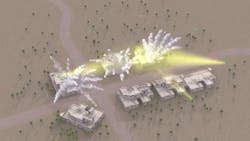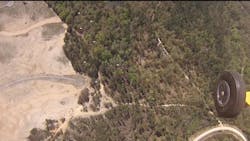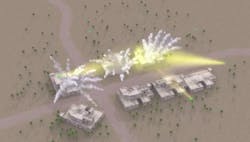The Office of Naval Research’s (ONR) LOCUST (LOw-Cost Unmannded aerial vehicle Swarming Technology) test system can rapidly launch up to 30 cooperative drones (Fig. 1). The tube-launched drones unfold after they are ejected. The tube approach has a small footprint and it allows a large number of drones to be moved and launched quickly.
1. ONR's tube-launched LOCUST drones unfold after they are launched and they fly autonomously, cooperating with each other.
The 1-m-long drones are from BAE Systems. The Sensintel Coyote drone is designed to be launched from a tube that matches a standard A-size sonobuoy. The front, rear, and rudder wings fold out after the UAV is ejected from the tube. A propeller on the rear also unfolds. The battery-powered drone can fly for 90 minutes at 60 knots. It has a flight ceiling of 20,000 ft. The Coyote can transmit full-motion video up to 20 nm using a 2 W S-band transmitter.
The drones fly in a cooperative swarm using wireless communication to coordinate their efforts. For now, it is a matter of flying in formation (Fig. 2). Multiple tests have been done recently using the Coyotes and multi-tube launcher.
In the future, the actions of individual and groups of drones can vary based on their objectives and what their sensors provide. A drone that detects an object like a target may have other drones search nearby areas or provide a more detailed examination of the spotted target (Fig. 3).
ONR has a variety of use cases from search-and rescue to offensive and defensive augmentation.
About the Author
William G. Wong
Senior Content Director - Electronic Design and Microwaves & RF
I am Editor of Electronic Design focusing on embedded, software, and systems. As Senior Content Director, I also manage Microwaves & RF and I work with a great team of editors to provide engineers, programmers, developers and technical managers with interesting and useful articles and videos on a regular basis. Check out our free newsletters to see the latest content.
You can send press releases for new products for possible coverage on the website. I am also interested in receiving contributed articles for publishing on our website. Use our template and send to me along with a signed release form.
Check out my blog, AltEmbedded on Electronic Design, as well as his latest articles on this site that are listed below.
You can visit my social media via these links:
- AltEmbedded on Electronic Design
- Bill Wong on Facebook
- @AltEmbedded on Twitter
- Bill Wong on LinkedIn
I earned a Bachelor of Electrical Engineering at the Georgia Institute of Technology and a Masters in Computer Science from Rutgers University. I still do a bit of programming using everything from C and C++ to Rust and Ada/SPARK. I do a bit of PHP programming for Drupal websites. I have posted a few Drupal modules.
I still get a hand on software and electronic hardware. Some of this can be found on our Kit Close-Up video series. You can also see me on many of our TechXchange Talk videos. I am interested in a range of projects from robotics to artificial intelligence.




